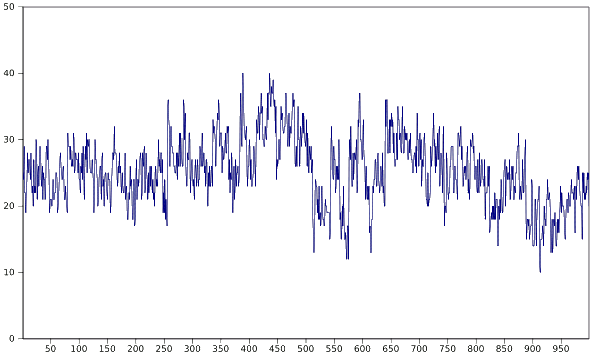
Algorithmic Music
January 19, 2011 Musical composition is a lot like theorem generation in mathematics. You have a set of rules, and you turn the crank to generate something interesting within that rule set. It sounds mechanical and not at all creative; but it's the "something interesting" part that differentiates good composers and good mathematicians from mere hacks. The idea that you can generate music algorithmically has been with us longer than computers. A method of generating music by stringing together short musical phrases randomly, usually by casting lots, was popular in the eighteenth century. This technique was known as Musikalisches Würfelspiel, or the Musical Dice Game. Joseph Haydn composed such an algorithmic composition, called the Philharmonic Joke, in 1790; but the most famous example of this type of composition is ascribed to Mozart. Mozart's method was sold as a game by his publisher in 1792, although we're not sure that Mozart approved. In this game, musical phrases were randomly selected by dice throws to piece together musical compositions. You can try Mozart's game using an online implementation,[1] or you can hear a minuet that was generated for me, now. I was interested in electronic music from an early age, and I designed and built several electronic music synthesizers in the 1970s. Recently, I was surprised to find that one of my experimental circuits has seen a revival on the Internet. I dabbled with algorithmic computer composition in my graduate schools days when I had access to a nice mainframe, but a turning point was the publication of the article, "1/f-noise in music and speech," by Richard F. Voss and John Clarke in a 1975 issue of Nature.[2] Voss subsequently communicated to Martin Gardner a simple algorithm for generating 1/f-noise via dice throws. This was essentially a low pass filter applied to the casting of multiple dice. A simple C language implementation that generated the data shown in the figure can be found here. A thousand samples of 1/F noise calculated by the Voss dice-throwing algorithm. See Ref. 3.
Not only was the Voss algorithm, which I generalized to dice with n faces, useful for generating music, but I wrote a program that used it to simulate my typing on a daisy-wheel printer. When my office door was closed, the cadence sounded so human that everyone believed I was actually hard at work on a manuscript while I was really elsewhere, playing in my lab. With the demise of impact printers and the transition from actual typing to electronic word processing, you'll need to find some other technique. I hear that the fake teleconference works just as well.
I was reminded of all this when I read a review of an exhibit at the Los Angeles Museum of Contemporary Art, Pacific Design Center, about the work of composer, Iannis Xenakis (May 29, 1922 - February 4, 2001).[4] Xenakis is known for his use of algorithmic composition techniques, but few know that he worked originally as an architect and was employed by Le Corbusier in Paris. He left Le Corbusier in 1959 in a dispute about Le Corbusier's taking too much credit for Xenakis' designs, including the very geometrical Philips Pavilion of the Brussel's Expo-58. This pavilion was composed of hyperbolic paraboloids, a shape that Xenakis realized would diffuse echoes.
A thousand samples of 1/F noise calculated by the Voss dice-throwing algorithm. See Ref. 3.
Not only was the Voss algorithm, which I generalized to dice with n faces, useful for generating music, but I wrote a program that used it to simulate my typing on a daisy-wheel printer. When my office door was closed, the cadence sounded so human that everyone believed I was actually hard at work on a manuscript while I was really elsewhere, playing in my lab. With the demise of impact printers and the transition from actual typing to electronic word processing, you'll need to find some other technique. I hear that the fake teleconference works just as well.
I was reminded of all this when I read a review of an exhibit at the Los Angeles Museum of Contemporary Art, Pacific Design Center, about the work of composer, Iannis Xenakis (May 29, 1922 - February 4, 2001).[4] Xenakis is known for his use of algorithmic composition techniques, but few know that he worked originally as an architect and was employed by Le Corbusier in Paris. He left Le Corbusier in 1959 in a dispute about Le Corbusier's taking too much credit for Xenakis' designs, including the very geometrical Philips Pavilion of the Brussel's Expo-58. This pavilion was composed of hyperbolic paraboloids, a shape that Xenakis realized would diffuse echoes.
 | Iannis Xenakis (Courtesy of Friends of Xenakis). |
References:
- John Chuang, "Mozart's Musikalisches Würfelspiel - A Musical Dice Game for Composing a Minuet," 1995.
- Richard F. Voss and John Clarke, "'1/fnoise' in music and speech," Nature, vol. 258, no. 5533 (November 27, 1975), pp. 317-318.
- Martin Gardner, "Fractal Music, Hypercards and more...," W.H. Freeman and Company, New York, 1992, pp. 12-18.
- Jonathon Keats, "How an architect took music back to mathematical roots," New Scientist, December 6, 2010.
- HighC web Site.
- Squidoo - Experimental Computer Music and Electronic Music Creation Web Site.
- Richard F. Voss and John Clarke, "'1/fnoise' in music and speech," Nature, vol. 258, no. 5533 (November 27, 1975), pp. 317-318.